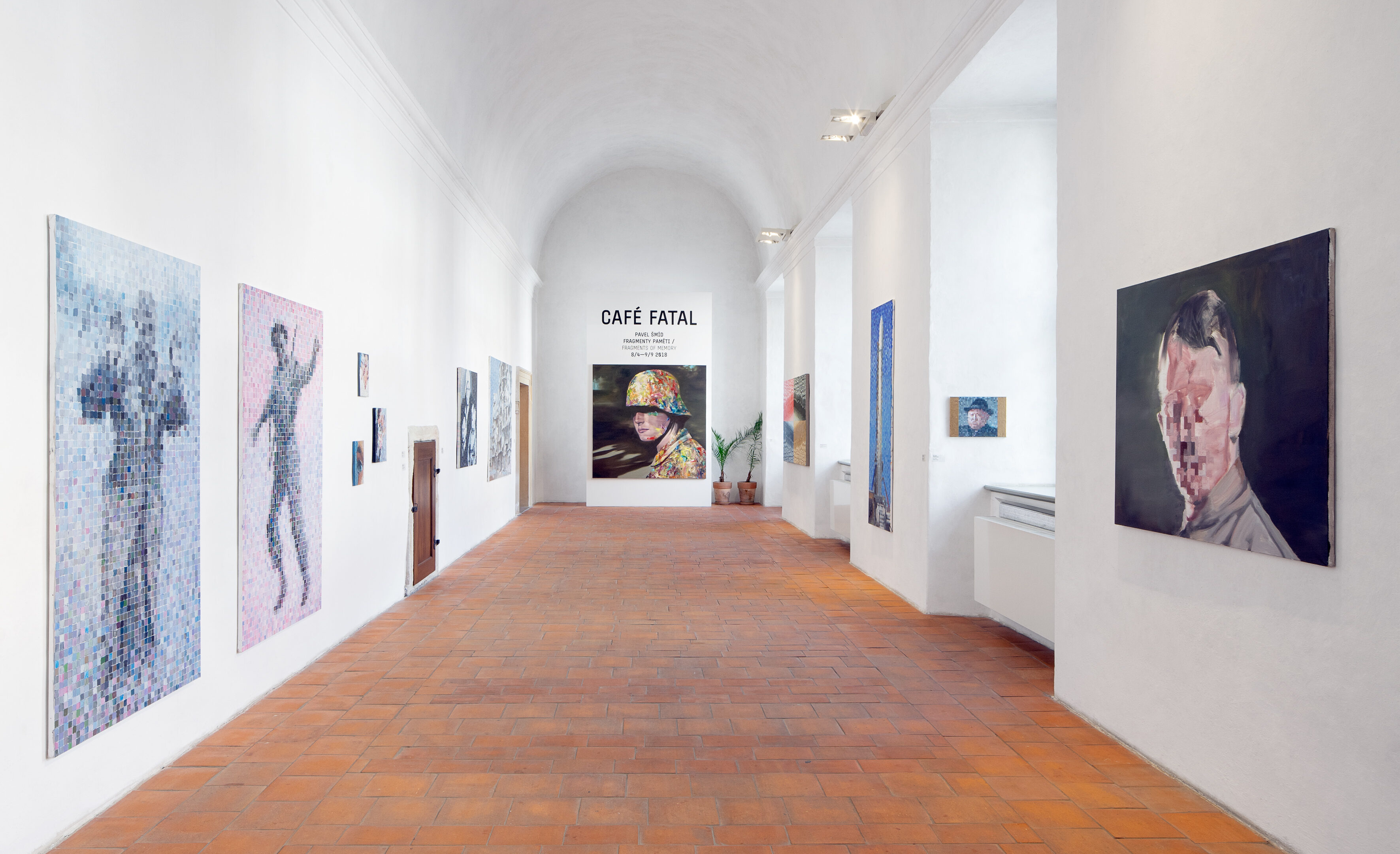The exhibition is part of Pavel Šmíd’s long-term series exploring the influence and impact of ‘grand history’ on the everyday lives of ordinary people.
09. 09. 2018

The exhibition is part of Pavel Šmíd’s long-term series exploring the influence and impact of ‘grand history’ on the everyday lives of ordinary people.
The exhibition is part of Pavel Šmíd’s long-term series exploring the influence and impact of ‘grand history’ on the everyday lives of ordinary people. Through his paintings, Šmíd tries to find a way of shifting this classical medium so that it will not just work with visual aesthetics or succumb to literary and pathos-laden copies of reality, but also create new and surprising contexts.
Šmíd blurs and pixellates realistic painting into mosaic-like patterns that lose their clear contours, thus causing the painting to disintegrate before our eyes. His mosaic-like paintings present the viewer with an uncertainty of form and meaning offering a wide range of possible interpretations. The paintings seem to fade from memory, only to reappear in the future in a different context. Important aspects of Šmíd’s work include multiplication, repetition and installation. In this sense, he sees no difference between banal and ‘important’ information or between large and small paintings or objects. He is interested first and foremost in telling a story that the viewer can piece together him or herself from the fragments of information. Another characteristic feature of his work is the combination of personal (Family, Portrait of a Soldier) and public or social themes containing for the most part universal meanings (Ruins, Broken City, Rocket). His paintings contradict, reassess and reconstruct visual records, situations and atmospheres, no matter whether they are supposed to be someone’s forgotten memories from a family album or iconic scenes from the turbulent history of the second half of the 20th century, framed by the misery and degradation of mankind by totalitarian regimes based on the ideologies of communism, Nazism and fascism. This series of war paintings evokes not just historical conflicts and crisis, but those of the present day as well. Šmíd brilliantly works with symbols and signs; he uses ironic hyperbole to playfully point to the spectre of demagoguery, despotism and totalitarianism through pop art or a mixture of styles.
War and totalitarianism are the subject of Lenin – An Attempt at Humanization, in which Vladimir Ilyich’s green cheeks and forehead make him look like some kind of extra-terrestrial ‘Illuminati’, a lizard from outer space come to spread his twisted ideology on Earth. Another painting, this one depicting Hitler, shows the dictator in three different colour versions posing as an angry little boy from the Hitlerjugend whose power has been weakened to the size of the boards in a puppet theatre. It depicts the ridiculousness and smallness of the kind of inflated ego we repeatedly find inside the souls of despotic tyrants. Another eloquent work is 4 Armies, 4 Colours – a painting showing people’s pack-like mob behaviour, here embodied by a difficult-to-identify army in which individual life has no value while the mass of soldiers imposingly marches on in multiple colour versions. Even the paintings division into four fields amplifies the feeling that the original idea has been turned upside-down, which evokes additional levels of meaning such as the superiority of foot-soldiers of a ‘higher order’. The original imagery is thus given a more abstract level. The black-and-white Cossack Ornament works in a similar manner.
The thematically somewhat depressing canvases alternate between light everyday motifs and images of intimate family life that despite their melancholy subtext represent a positive way out of an otherwise ambivalent reality. One such work is Doggie, an ordinary snapshot of an energetic dog that, after having its picture taken, runs up to its master for a treat or at least a friendly scratch behind the ears. Another such image is Child, whose titular character has been born an unblemished individual into a complicated world, and for the time being quietly rests in an angelic embrace before it will have to bear all the joys and troubles of life. We find a somewhat ambivalent message in The Kiss, a rasterized mosaic image of two newlyweds kissing that can be understood as a snapshot of a joyous moment or – within the context of the other paintings – as an ironic reference to the legendary ‘kiss of death’ between Brezhnev and Husák after the installation of Husák’s normalization government in occupied Czechoslovakia.
The exhibited works by Pavel Šmíd forces us to reflect on contemporary socio-political contexts, in particular the tendencies towards populism and extremism that we can see in America and Europe, including Czech society, which we consider a crisis of liberal-democratic systems. Šmíd’s approach is enthusiastic in its sense of objective distance and sarcastic commentary of the collage-like chaos of information that we are fed every day by the media and social networks. Šmíd in particular appeals to our critical thinking and common sense as we go through our daily lives.